黄浦江流域典型药物和个人护理品的含量及分布特征
2014-05-13吕树光赵文涛邱兆富华东理工大学国家环境保护化工过程环境风险评价与控制重点实验室上海007同济大学环境科学与工程学院污染控制与资源化研究国家重点实验室上海0009清华威立雅先进环境技术联合研究中心北京00084
王 丹,隋 倩*,吕树光,赵文涛,邱兆富,余 刚(.华东理工大学,国家环境保护化工过程环境风险评价与控制重点实验室,上海 007;.同济大学环境科学与工程学院,污染控制与资源化研究国家重点实验室,上海0009;.清华-威立雅先进环境技术联合研究中心,北京 00084)
黄浦江流域典型药物和个人护理品的含量及分布特征
王 丹1,隋 倩1*,吕树光1,赵文涛2,邱兆富1,余 刚3(1.华东理工大学,国家环境保护化工过程环境风险评价与控制重点实验室,上海 200237;2.同济大学环境科学与工程学院,污染控制与资源化研究国家重点实验室,上海200092;3.清华-威立雅先进环境技术联合研究中心,北京 100084)
采用固相萃取-高效液相色谱/串联质谱法(SPE-HPLC-MS/MS)分析上海市黄浦江流域7种典型药物和个人护理品(PPCPs)的含量水平.结果表明,所建立的分析方法具备良好的回收率(87%~107%)、相对标准偏差(<14%)及方法定量限(0.1~1.1ng/L),满足水体中微量污染物的检测要求.应用该方法检测得到,上海市黄浦江流域水体中目标 PPCPs的含量在 药物和个人护理品;高效液相色谱/串联质谱法;黄浦江;浓度水平 药物和个人护理品(PPCPs)因其在天然水环境中被频繁检出以及对水生生物的潜在危害,受到了广泛关注.近年来,随着分析检测技术的提高,已有上百种PPCPs在河流[1-4]、湖泊[1-2,5]、海洋[6-7]及地下水[8]等天然水环境中被检出.据报道,水环境中残留的PPCPs会导致细菌产生耐药性及抗生素抗性基因的传递和扩散,干扰天然细菌的生态系统,从而威胁人类健康[9].另外,水体中的PPCPs还可能会导致人类致癌或过敏性反应,对水生生物和土壤微生物产生危害[10]. 目前,不少研究者考察了PPCPs在珠江、九龙江和南明河等河流中的存在水平和分布特点[3-4,11-16],然而,现有的针对上海市最重要的河流黄浦江开展的相关研究还不多,已有研究大多集中在抗生素类物质上[17-19],且涉及的河流区域较有限[17-21].考虑到黄浦江同时兼具饮用水源、航运、灌溉、渔业和旅游等多种功能,且近年来受上海市工业和城市活动影响较大,因此在黄浦江流域开展更大范围的针对多类别PPCPs残留的监测具有重要的意义. 本文采用固相萃取-高效液相色谱/串联质谱(SPE-HPLC-MS/MS)分析方法,研究了7种典型 PPCPs(苯扎贝特,卡马西平,咖啡因,双氯芬酸,吉非罗平,美托洛尔和甲氧苄啶)在黄浦江流域及部分支流中的含量水平和空间分布规律,以揭示黄浦江流域上述PPCPs的污染特征. 1.1 试剂与标准品 PPCPs标准品(表 1):苯扎贝特(BF),卡马西平(CBZ),咖啡因(CF),双氯芬酸(DF),吉非罗平(GF),美托洛尔(MTP)和甲氧苄啶(TP)分别购自Sigma-Aldrich公司(德国)和 Dr. Ehrenstorfer公司(德国). 表1 7种PPCPs的理化性质、物质结构、保留时间及质谱参数Table 1 Physicochemical property, chemical structure, retention time and corresponding IS for selected PPCPs 内标(IS):非那西汀-13C(Phenacetin-13C, 99%),2-甲4-氯丙酸-3D(Mecoprop-3D)和吉非罗平-6D(GF-6D,98%),分别购自 Sigma-Aldrich和Dr. Ehrenstorfer公司. 其他试剂:甲醇、甲酸为色谱纯,其余药品或试剂均为分析纯. 1.2 样品采集 样品于2012年5月在黄浦江干流及5条支流中采集,采样点从淀山湖开始至黄浦江入长江口,包括上、中、下游共25个采样点(图1),每点水样采集2份.受采样设备的限制,采用瞬时采样法,样品置于 1L棕色玻璃瓶中,采集后迅速运至实验室4℃保存,待处理. 图1 黄浦江采样点分布Fig.1 Sampling sites location in Huangpu River 1.3 样品处理与分析 用 47mm的玻璃纤维滤纸(GF/F,Whatman)过滤水样,取 400mL过滤后的水样,加入 200µL内标混合液,调节pH =7.0.固相萃取时,先用5mL甲醇、3×5mL高纯水依次通过 SPE小柱(Oasis HLB,6mL/500mg,Waters)进行活化和平衡,而后将含有内标的过滤液以5~10mL/min的流速通过SPE小柱.接着将5mL甲醇/水混合液(V/V=1:19)通过SPE小柱,以清洗小柱,并继续抽真空30min,除去水份.再以1mL/min的流速用甲醇洗脱小柱,洗脱液收集于 10mL具塞玻璃刻度离心管中.最后以高纯氮吹扫洗脱液(水浴温度 35 )℃至刚好吹干,加入 0.4mL甲醇/水混合液(V/V=1:4),置于涡旋振荡器混合均匀,移入自动进样样品瓶,待色谱分析. 采用高效液相色谱(HPLC, Ultimate3000, Dionex, USA)-串联质谱(ESI-MS/MS, API3200, AB Sciex, USA)对样品进行测定.梯度洗脱,离子源为正(ESI+)、负(ESI-)两种模式,通过多反应监测(MRM)模式对待测物进行定量分析. 1.4 方法回收率及质量控制 实验的准确性由回收率实验和空白实验保证.方法回收率实验分别以高纯水和地表水为介质,分别取400mL水样,定量加入200µL浓度为400µg/L的PPCPs混标溶液和200µL内标溶液,按照 1.3方法对样品进行前处理和仪器分析,采用内标法定量.对于地表水,需同时进行加标和不加标两种样品分析,对比两种样品测得浓度的差值与已知加标浓度,得到地表水中各PPCPs的相对回收率. 空白实验的目的是识别并定量采样、前处理及仪器分析等阶段目标化合物的污染,包括现场空白和程序空白.采样时,将 500mL高纯水置于棕色玻璃采样瓶中,携带至取样现场,采样时暴露于周围环境,采样结束后,与实际水样一同运送至实验室,测定其中目标PPCPs的浓度,该样品为现场空白.实验室分析前,再准备一定量的高纯水,测定其中目标PPCPs的浓度,作为程序空白.实际样品测试时,每批除实际水样和1个程序空白外,还包括1个以高纯水为介质的加标样品,以监测该批样品各PPCPs在前处理过程中的回收率情况.此外,每点水样采集两份,进行平行双样测定,以保证实验测定的精密性. 2.1 方法性能评价 空白实验结果表明,空白实验组中全部目标PPCPs的值均小于方法定量限.检测方法的线性关系、定量限和加标回收率的结果见表2. 各 PPCP标准曲线的浓度范围为 2~400µg/L,根据目标化合物与对应内标物峰面积的比值建立标准曲线,各物质线性相关性均大于0.99. 为考察方法的重现性,回收率实验中,每种介质均做4组平行样.如表2所示,由于实际水样中干扰组分过多导致了回收率下降,高纯水中 7种PPCPs的回收率为 92%~107%,地表水中的回收率为 87%~103%.此外,平行实验结果表明,两种水样中各PPCP的变异系数均小于14%,符合环境样品分析方法的一般要求. 表2 7种PPCPs在高纯水和河水中的相对回收率(RR)、仪器定量限(IQL)、定量限(LOQ)和线性关系Table 2 Relative recovery (RR), instrumental quantification limit (IQL), limit of quantification (LOQ) and linear equation for selected PPCPs in the river and ultrapure water 以目标化合物色谱峰信噪比(S/N)为10:1的浓度作为仪器定量限(IQL).方法定量限(LOQ)根据各目标化合物的仪器检出限、回收率和浓缩倍数等确定,其计算公式如式(1)所示. 式中:R为目标化合物在对应介质中的回收率;C为样品浓缩倍数. 如表2所示,目标PPCPs的方法定量限较低,范围为 0.1~1.1ng/L.通过比较,该分析方法的灵敏度优于很多基于HPLC-MS/MS,UPLCTOF和HPLC-UV建立的检测方法定量限的报 道[12,22-24]. 2.2 PPCPs在黄浦江流域的浓度水平 黄浦江流域中PPCPs的浓度与检出频率如图2所示.进行统计分析时,低于方法定量限的浓度以方法定量限浓度的50%代替[25-26]. 7种PPCPs在所有水样中均被检出,其中CF和CBZ的检出频率为100%,BF仅在个别点以较低的浓度检出.各物质的浓度范围为 总体上看,黄浦江中PPCPs的含量处于较低的水平(表3).以使用较为频繁的CF为例,黄浦江中的浓度范围为 17~824ng/L,远低于对西班牙(最大值2130ng/L)[27]和北京(7051ng/L)[13]等地表水中的相关报道.又如,本研究中抗生素 TP的浓度在 图2 7种PPCPs在黄浦江流域的浓度水平及检出频率Fig.2 7 PPCPs concentrations and frequencies of detection in Huangpu River 为初步评价黄浦江流域水环境中PPCPs的存在可能导致的环境风险,我们在其最大浓度条件下,采用公式(2)对其风险商值进行计算.式中:RQ为风险商值;MEC为实测环境浓度; PNEC为预测无影响浓度. 表3 目标PPCPs在其他国家和地区的存在水平与本研究比较Table 3 Comparison of target PPCPs concentrations between other countries/regions and this study 如果RQ值大于或等于1,即表示该污染物可能会对水环境产生负面影响[39].如表4所示,目标PPCPs的风险商值在最大浓度条件下均远小于1,说明不会对环境造成明显的不利影响.在挪威 [40]和珠江[15]等很多地表水环境中的 BF均表现出对生态环境具有潜在的风险,而黄浦江流域的BF风险商值仅为0.001.需要指出的是,生态风险商的计算仅针对单一物质,而多种物质共同作用引起的环境风险可能大于单一物质[41]. 表4 水环境中部分PPCPs的初步生态风险评价Table 4 The primary risk assessment for some PPCPs in aquatic environmental 2.3 空间分布 图 3为黄浦江干流和支流上各采样点PPCPs的含量分布.总体上看,干流和支流均呈现上游检出的物质种类少、含量低,下游检出的物质种类多、含量增加的趋势.这是由于在黄浦江上游地区,城市化和人类活动相对较少,而随着河流流向中下游,城市化加剧,人口增多,药物使用和排放也增多,所以PPCPs的含量水平呈现由上游到下游逐渐增高的趋势. 此外,黄浦江属潮汐河,下游地区是非正规半日潮,而下游采样时正处黄浦江涨潮期,相对盐度较高的河水可能破坏PPCPs在水-沉积物之间的吸附平衡[11,14],使吸附在沉积物中的PPCPs重新释放至水相,从而导致下游地区PPCPs浓度偏高.很多研究也已经表明,悬浮物和沉积物等颗粒物对微量有机污染物的吸附是不容忽视的[45-47]. 由图3可以看出,黄浦江流域支流的污染程度较干流严重,这可能与采样点位置的选取有关.T1和T2、T7和T8、T10和T11分别位于污水厂附近,根据以前的报道,城市污水处理厂很可能是地表水污染的主要来源[21,48].河水的稀释作用是影响河水中PPCPs含量的重要因素[21].例如支流T4、T6、T8和T11在汇入黄浦江后,在其下游100~500m处对应的采样点分别为S7、S9、S10和S14,物质含量都有所降低. 图3 黄浦江干流和支流各采样点PPCPs的含量分布Fig.3 Total concentrations of selected PPCPs in streams and tributaries 3.1 采用固相萃取-高效液相色谱/串联质谱法检测地表水中苯扎贝特、卡马西平、咖啡因等7种 PPCPs,分析方法具备良好的回收率(87%~107%),相对标准偏差(<14%)和方法定量限(0.1~1.1ng/L),满足环境分析的需要. 3.2 7种目标PPCPs在黄浦江流域均以不同程度被检出,其中 CF检出率达 100%,且浓度最高,最大浓度为824ng/L,CBZ浓度次之,而BF的污染水平较低.通过对比国内外地表水中PPCPs的浓度可以发现,黄浦江地表水中PPCPs的污染处于中等偏低水平,符合我国药物消费特点. 3.3 从污染物的空间分布看,黄浦江流域目标PPCPs的下游污染比上游严重,支流污染大于干流. [1] Tixier C, Singer H P, Oellers S, et al. Occurrence and fate of carbamazepine, clofibric acid, diclofenac, ibuprofen, ketoprofen and naproxen in surface waters [J]. Environmental Science and Technology, 2003,37(6):1061-1068. [2] Glen R B, Helge R, Deborah A G, et al. Pharmaceuticals and personal care products (PPCPs) in surface and treated waters of Louisiana, USA and Ontario, Canada [J]. Science of the Total Environment, 2003,311(1-3):135-139. [3] 欧丹云,陈 彬,陈灿祥,等.九龙江下游河口水域抗生素及抗性细菌的分布 [J]. 中国环境科学, 2013,33(12):2243-2250. [4] Zhang D D, Lin L F, Luo Z X, et al. Occurrence of selected antibiotics in Jiulongjiang River in various seasons, South China [J]. Journal of Environmental Monitor, 2011,13:1953-1960. [5] Buser H R, Theobald M D. Occurrence of the pharmaceutical drug clofibric acid and the herbicide mecoprop in various Swiss lakes and in the North Sea [J]. Environmental Science and Technology, 1998,32(1):188-192. [6] Weigel S, Kuhlmann J, Huhnerfuss H. Drugs and personal care products as ubiquitous pollutants: occurrence and distribution of clofibric acid, caffeine and DEET in the North Sea [J]. Science of the Total Environment, 2002,295(1-3):131-141. [7] 薛保铭,杨惟薇,王英辉,等.钦州湾水体中磺胺类抗生素污染特征与生态风险 [J]. 中国环境科学, 2013,33(9):1664-1669. [8] Barnes K K, Kolpin D W, Furlong E T, et al. A national reconnaissance of pharmaceuticals and other organic wastewater contaminants in the United States-I Groundwater [J]. Science of the Total Environment, 2008,402(2/3):192-200. [9] 王路光,朱晓磊,王靖飞,等.环境水体中的残留抗生素及其潜在风险 [J]. 工业水处理, 2009,29(5):10-14. [10] Gobel A, McArdell C S, Suter M J, et al. Trace determination of macrolide and sulfonamide antimicrobials, a human sulfonamide metabolite and trimethoprim in wastewater using liquid chromatography coupled to electrospray tandem mass spectrometry [J]. Analytical Chemistry, 2004,76(16):4756-4764. [11] 徐维海,张 干,邹世春,等.香港维多利亚港和珠江广州河段水体中抗生素的含量特征及其季节变化 [J]. 环境科学, 2006, 27(12):2458-2462. [12] Peng X Z, Tan J H, Tang C M, et al. Multiresidue determination of fluoroquinolone, sulfonamide, trimethoprim and chloramphenicol antibiotics in ruban waters in China [J]. Environmental Toxicology and Chemistry, 2008,27(1):73-79. [13] Zhou H D, Huang X, Wang X L, et al. Behaviour of selected endocrine-disrupting chemicals in three sewage treatment plants of Beijing, China [J]. Environmental Monitor Assess, 2010,161(1-4):107-121. [14] Liu H, Zhang G P, Liu C Q, et al. The occurrence of chloramphenicol and tetracyclines in municipal sewage and the Nanming River, Guiyang City, China [J]. Journal of Environmental Monitor, 2009,11:1199-1205. [15] Zhao J L, Ying G G, Liu Y S, et al. Occurrence and a screening-level risk assessment of human pharmaceuticals in the Pearl River system, South China [J]. Environmental Toxicology Chemistry, 2010,29(6):1377-1384. [16] Zheng S L, Qiu X Y, Chen B, et al. Antibiotics pollution in Jiulong River estuary: Source, distribution and bacterial resistance [J]. Chemosphere, 2011,84(11):1677-1685. [17] Wang P H, Yuan T, Hu J Y, et al. Determination of cephalosporin antibiotics in water samples by optimised solid phase extraction and high performance liquid chromatography with ultraviolet detector [J]. Environmental Analytical Chemistry, 2011,91(13): 1267-1281. [18] Shi L, Zhou X F, Zhang Y L, et al. Development of an analytical method for eight fluoroquinolones using solid-phase extraction and liquid chromatography with fluorescence detection [J]. Environmetal Analytical Chemistry, 2010,90(14/15):1085-1098. [19] Jiang L, Hu X L, Yin D Q, et al. Occurrence, distribution and seasonal variation of antibiotics in the Huangpu River, Shanghai, China [J]. Chemosphere, 2011,82(6):822-828. [20] Duan Y P, Meng X Z, Wen Z H. Acidic pharmaceuticals in domestic wastewater and receiving water from hyperurbanization city of China (Shanghai): environmental release and ecological risk [J]. Environmental Science Pollution Research, 2013,20(1):108-116. [21] Zhou X F, Dai C M, Zhang Y L, et al. A preliminary study on the occurrence and behavior of carbamazepine (CBZ) in aquatic environment of Yangtze River Delta, China [J]. Environmental Monitor Assess, 2011,173(1-4):45-53. [22] Vieno N M, Tuhkanen T, Kronberg L. Analysis of neutral and basic pharmaceuticals in sewage treatment plants and in recipient rivers using solid phase extraction and liquid chromatographytandem mass spectrometry detection [J]. Journal of Chromatography A, 2006, 1134(1/2):101-111. [23] Lacey C, Mcmahon G, Bones J, et al. An LC-MS method for the determination of pharmaceutical compounds in wastewater treatment plant influent and effluent samples [J]. Talanta, 2008, 75:1089-1097. [24] Hernando M D, Heath E, Petrovic M, et al. Trace-level determination of pharmaceutical residues by LC-MS/MS in natural and treated waters: A pilot-survey study [J]. Analytical and Bioanalytical Chemistry, 2006,385(6):985-991. [25] Glelt A. Estimation for small normal data sets with detection limits [J]. Environmental Science and Technology, 1985,19(12): 1201-1208. [26] Reemtsma T, Weiss S, Mueller J, et al. Polar pollutants entry into the water cycle by municipal wastewater: A European perspective [J]. Environmental Science and Technology, 2006,40(17):5451-5458. [27] Dolores C M, Julia M, Juan L S, et al. Occurrence, temporal evolution and risk assessment of pharmaceutically active compounds in Doñana Park [J]. Journal of Hazardous Materials, 2010,183(1-3):602-608. [28] Wu C X, Alison L S, Jason D W. Determination of the persistence of pharmaceuticals in biosolids using liquid-chromatography tandem mass spectrometry [J]. Chemosphere, 2008,73(4):511-518. [29] Paul H R, Kevin V T. The occurrence of selected pharmaceuticals in wastewater effluent and surface waters of the lower Tyne catchment [J]. Science of The Total Environment, 2006,356(1-3): 143-153. [30] Yeomin Y, Jaena R, Jeill O, et al. Occurrence of endocrine disrupting compounds, pharmaceuticals and personal care products in the Han River (Seoul, South Korea) [J]. Science of The Total Environment, 2010,408(3):636-643. [31] Sui Q, Huang J, Deng S B, et al. Occurrence and removal of pharmaceuticals, caffeine and DEET in wastewater treatment plants of Beijing, China [J]. Water Research, 2010,44(2):417-426. [32] Ternes T A. Occurrence of drugs in German se wage treatment plants and rivers [J]. Water Research, 1998,32(11):3245-3260. [33] Lishman L, Smyth S A, Sarafin K, et al. Occurrence and reductions of pharmaceuticals and personal care products and estrogens by municipal wastewater treatment plants in Ontario, Canada [J]. Science of the Total Environment, 2006,367(2/3): 544-558. [34] Justin M C, Steven J S, Mark S S, et al. Spatial and temporal analysis of pharmaceutical concentrations in the upper Tennessee River basin [J]. Chemosphere, 2008,73(8):1178-1187. [35] Barbara K H, Richard M D, Alan J G. The occurrence of pharmaceuticals, personal care products, endocrine disruptors and illicit drugs in surface water in South Wales, UK [J]. Water Research, 2008,42(13):3498-3518. [36] Bianca F S, Aleksandra J, Rebeca L S, et al. Occurrence and distribution of pharmaceuticals in surface water, suspended solids and sediments of the Ebro river basin, Spain [J]. Chemosphere, 2011,85(8):1331-1339. [37] Valcárcel Y, González A S, Rodríguez-Gil J L, et al. Detection of pharmaceutically active compounds in the rivers and tap water of the Madrid Region and potential ecotoxicological risk [J].Chemosphere, 2011,84(10):1336-1348. [38] Allison M V, Melody J B. Temporal variation of pharmaceuticals in an urban and agriculturally influenced stream [J]. Science of The Total Environment, 2011,409(21):4553-4563. [39] Tauxe W A, Alencastro L F, Grandjean D, et al. Occurrence of several acidic drugs in sewage treatment plants in Switzerland and risk assessment [J]. Water Research, 2005,39(9):1761-1772. [40] Grung M, Kallqvist T, Sakshaug S, et al. Environmental assessment of Norwegian priority pharmaceuticals based on the EMEA guide line [J]. Ecotoxicological and Environmetal Safety, 2008,71(2):328-340. [41] Flaherty C M , Dodson S I. Effects of pharmaceuticals on Daphnia survival, growth, and reproduction [J]. Chemosphere, 2005,61(2):200-207. [42] Lindqvist N, Tuhkanen T, Kronberg L. Occurrence of acidic pharmaceuticals in raw and treated sewages and in receiving waters [J]. Water Research, 2005,39(11):2219-2228. [43] Santos J L, Aparicio I, Alonso E. Occurrence and risk assessment of pharmaceutically active compounds in wastewater treatment plants. A case study: Seville city (Spain) [J]. Environment International, 2007,33(4):596-601. [44] Ferrari B, Paxeus N, Giudice R L, et al. Ecotoxicological impact of pharmaceuticals found in treated wastewaters: study of carbamazepine, clofibric acid and diclofenac [J]. Ecotoxicology and Environmental Safety, 2003,55(3):359-370. [45] Halling S B, Nielsen S N, Lanzky P F, et al. Occurrence, fate and effects of pharmaceutical substances in the environmental-a review [J]. Chemosphere, 1998,36:357-393. [46] Löffler D, Ternes T A. Determination of acidic pharmaceuticals, antibiotics and ivermectin in river sediment using liquid chromatography-tandem mass spectrometry [J]. Journal of Chromatography A, 2003,1021:133-144. [47] Beausse J. Selected drugs in solid matrices: a review of environmental determination, occurrence and properties of principal substances [J]. Trends in Analytical Chemistry, 2004,23: 753-761. [48] Xu W H, Zhang G, Zou S C, et al. A preliminary investigation on the occurrence and distribution of antibiotics in the Yellow River and its tributaries, China [J]. Water Environmental Research, 2009,81(3):248-254. Concentrations and distribution of selected pharmaceuticals and personal care products in Huangpu River. WANG Dan1, SUI Qian1*, LU Shu-guang1, ZHAO Wen-tao2, QIU Zhao-fu1& YU Gang3(1.State Environmental Protection Key Laboratory of Environmental Risk Assessment and Control on Chemical Process, East China University of Science and Technology, Shanghai 200237, China;2.State Key Laboratory of Pollution Control and Resource Reuse, College of Environmental Science and Engineering, Tongji University Shanghai 200092, China;3.THU-VEOLIA Joint Research Center for Advanced Environmental Technology, School of Environment, Tsinghua University, Beijing 100084, China). China Environmental Science, 2014,34(7):1897~1904 The concentrations of 7selected pharmaceuticals and personal care products (PPCPs) in the Huangpu River were determined by solid phase extraction and high liquid chromatography-electrospray tandem mass spectrometry (SPE-HPLC-MS/MS). The results showed that the developed analytical method obtained good recoveries (87~107%), relative standard deviation (<14%) and limit of quantification (0.1~1.1ng/L), satisfying the requirement to detect micropollutants in the surface water. By applying the method in Huangpu River, we found that compared to other reported studies, the contamination levels of target PPCPs were low in Huangpu River, with the concentrations varying from pharmaceuticals and personal care products;high liquid chromatography-electrospray tandem mass spectrometry method;Huangpu River;concentration X171 A 1000-6923(2014)07-1897-08 王 丹(1987-),女,江苏徐州人,华东理工大学硕士研究生,主要从事水环境中药物与个人护理品的调查与去除机理的研究. 关于《中国环境科学》网上投稿的通知 《中国环境科学》编辑部 2013-10-30 国家自然科学基金(51208199);中国博士后科学基金特别资助项目(2013T60429);国家环境保护环境微生物利用与安全控制重点实验室开放基金(MARC2011D032;MARC2011D044);环境模拟与污染控制国家重点联合实验室开放基金(12K02ESPCT);中央高校基本科研业务费专项资金 * 责任作者, 讲师, suiqian@ecust.edu.cn 《中国环境科学》编辑部为提高稿件处理的网络化水平和采编工作的效率,及时让作者了解稿件的处理情况,自2008年3月1日起已开通网上投稿查稿系统,请登陆网址: http://www.zghjkx.com.cn点击“作者在线投稿”进行注册后再按要求投稿,点击“作者在线查稿”进行查询.本刊不再接受纸件投稿和电子版稿件的E-mail投稿.特此通知.1 材料与方法
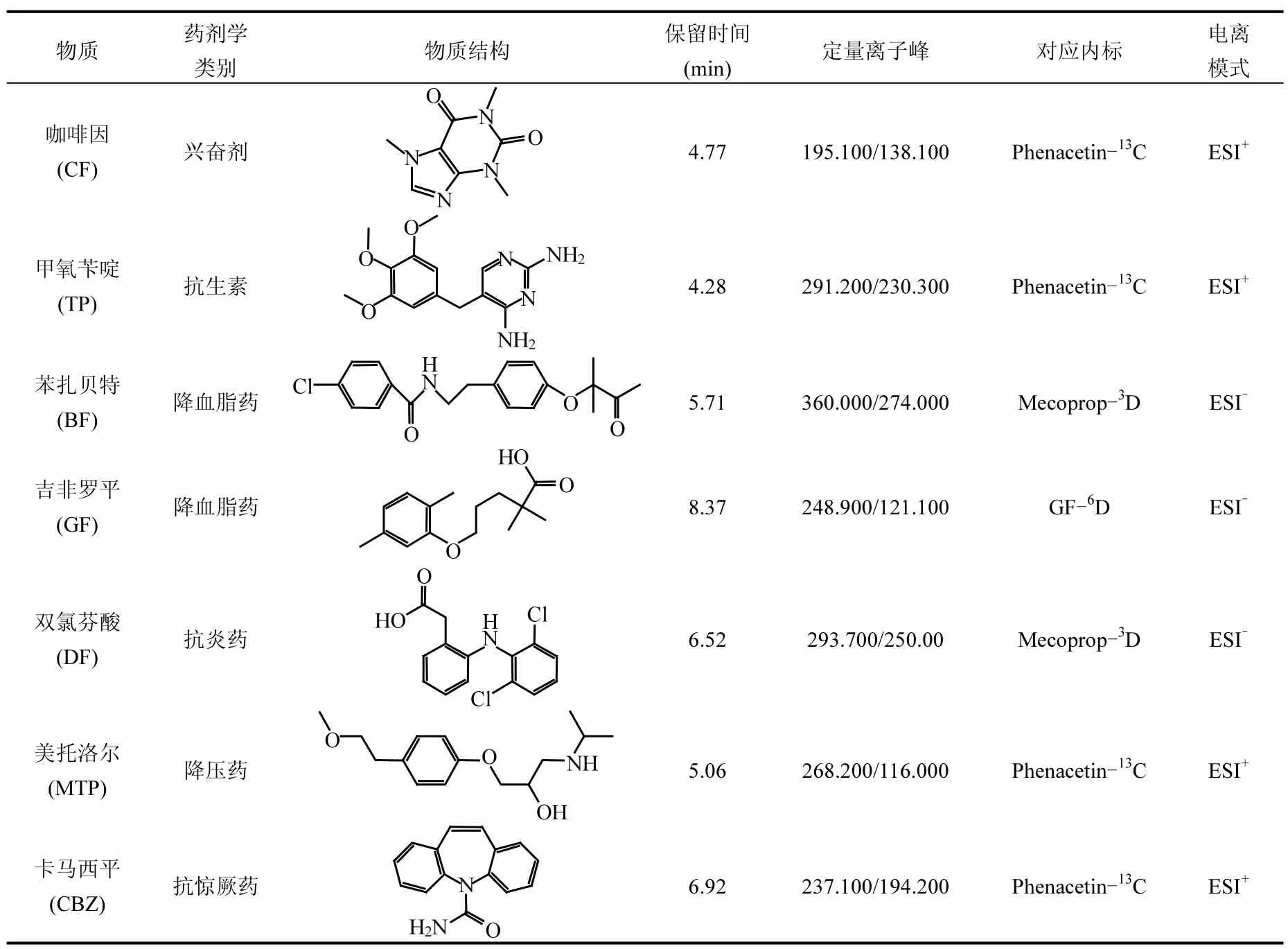

2 结果与讨论


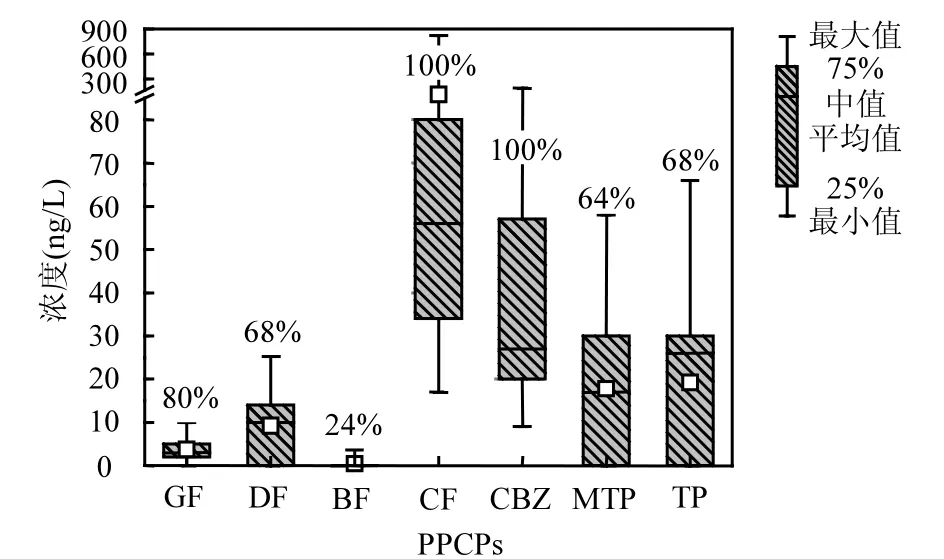

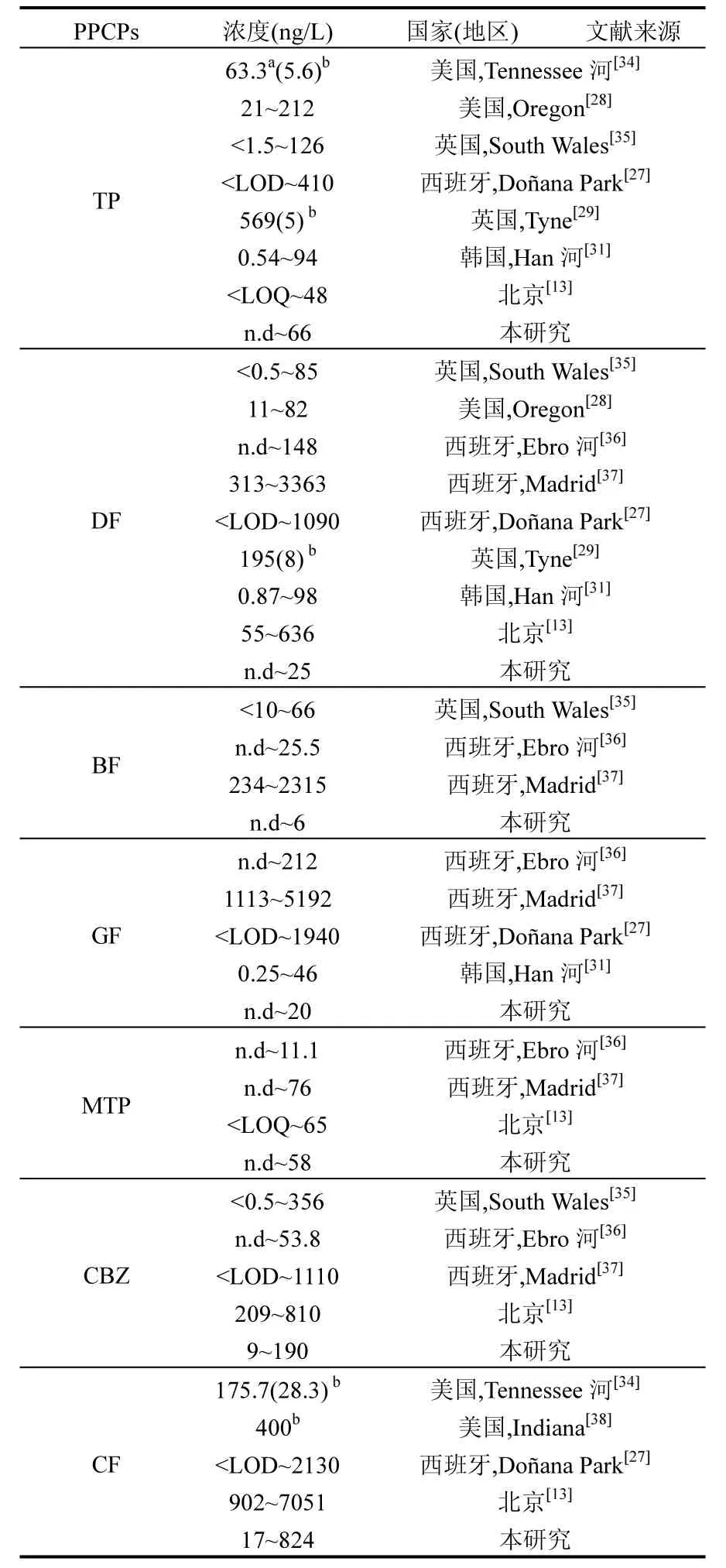
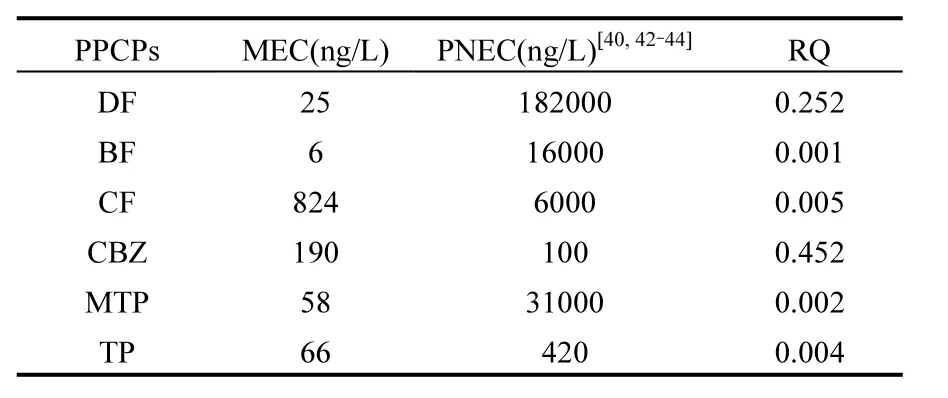
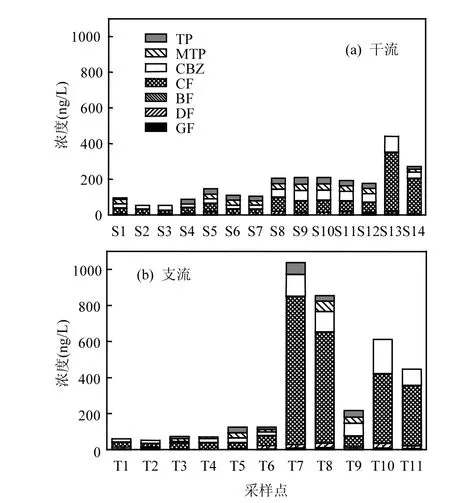
3 结论
